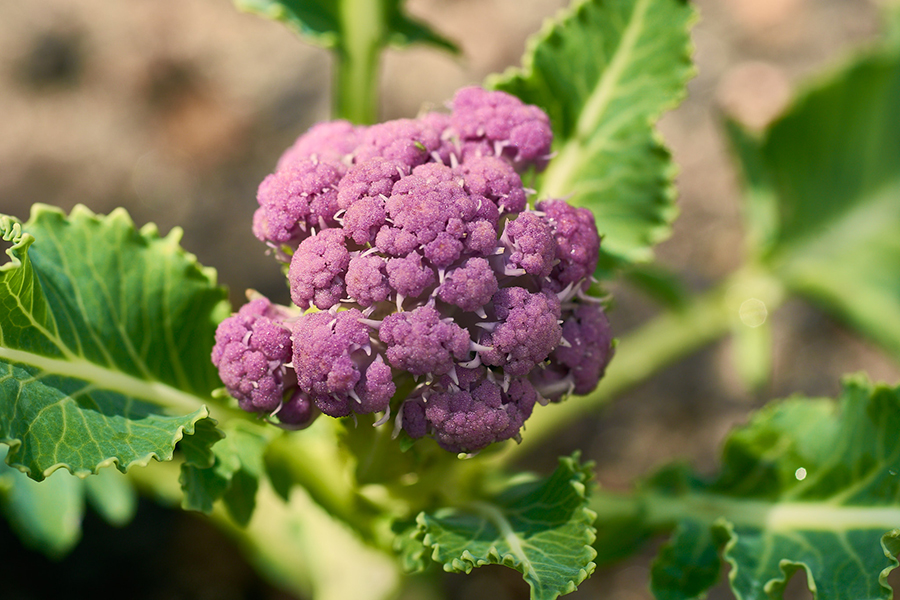Staff plant the seeds for a broader education in food and cooking
Linda Sutherland (Culinary Arts ’19) was waiting for this.
The Culinary Arts educational lab technician stands in a courtyard at NAIT’s Main Campus, a green space enclosed by dark brick walls. It’s a sunny, mild morning in late June and she’s joined by instructor Luisa Rizzi (Culinary Arts ’04), a long-time chef who started gardening during the pandemic. In front of them is a rectangular cedar planter – one of six along the north wall of the space.
Inside it is a short line of bean plants, each one about 15 centimetres tall.
A week ago, that soil was bare and, having sown seeds, Sutherland was getting concerned. “I was thinking we might have to dig those up and put something else in,” she says. But, as tends to be the case for gardeners, her patience was rewarded.
"There’s something to be said about planting the seed and washing the dishes at the end.”
The same might be said about the courtyard garden itself. After many months of activities being restricted on campus by the pandemic, NAIT executive approved the proposal from Culinary Arts and Professional Food Studies department head Perry Michetti (Cooking ’90) in late 2021.
It’s an idea that will no doubt bear fruit. As the understanding of the myriad benefits of local food continues to grow, culinary instructors and staff see the garden as a teaching tool to broaden food education by ensuring students get their hands truly dirty.
“I really think there’s something to be said about planting the seed and washing the dishes at the end,” says Michetti. “There’s a lot of things that happen in that journey.”
An experimental cornucopia

For years, Michetti had wondered about having a food garden at NAIT. He’d seen the resources going into maintaining the existing greenery and thought, “‘Why don’t we grow things [to eat]?’” he says. “That made more sense to me.”
When Michetti took the approved idea to program staff for support, “I had eight or 10 people put up their hand [and] say, ‘Absolutely.” Many stepped forward with seeds and plants from home gardens.
The result is an experimental cornucopia. “When the donations came in, we didn’t say no to anything,” says Rizzi. “It just meant more people were invested, which is what we wanted.”
In planter boxes built by NAIT’s Carpenter program now grow staples including beans, carrots and tomatoes, as well as more adventurous kohlrabi and frisée, a member of the endive family. One box is devoted to herbs. In the ground nearby sits a small patch of broccoli, brussel sprouts and cauliflower. Here and there, pansies and begonias add splashes of colour.

Just a few weeks in, much of the garden is thriving. Nevertheless, Sutherland will take notes for improvements during her summer of watering and weeding. Regardless of the shape of the harvest when fall term begins, she’s confident the pilot will serve its primary purpose: opening the eyes of aspiring chefs.
Often being from urban environments of manicured lawns and ornamental trees, “a lot of our students do not know where their food comes from,” says Sutherland. With this project, she adds, they’ll have a chance to truly appreciate “the full flavour of what food can be.”
More than cooking

Michetti would agree. “We need to teach students about food more than [just] cooking,” he says. That means covering sustainable production, reliable supply chains, the importance of buying local, mitigating waste, transforming what’s in season into creative dishes, and more.
He’s fine with the garden supplying but a fraction of the needs of the program, seeing its real value in getting “students [to] think that if they can do it here, they can do it when they leave.”
(That said, he and the instructors do hope to provide the ingredients for a few specials in Ernest’s, NAIT’s on-campus fine-dining restaurant.)
 “The new garden is a fantastic opportunity for students to learn about food sustainability and responsibility, both of which will apply to their future culinary careers,” says Peter Leclaire, NAIT’s vice-president academic.
“The new garden is a fantastic opportunity for students to learn about food sustainability and responsibility, both of which will apply to their future culinary careers,” says Peter Leclaire, NAIT’s vice-president academic.
“It’s important that we continue to enhance the experience of students in ways that also help meet the evolving needs of industry – and the garden and the curriculum that comes with it is a great example of this.”
The garden is the seed of several possibilities. Perhaps other courtyards and areas around NAIT could be cultivated in the future, says Michetti, with production going to more uses and greater student involvement, including planning, planting, tending, harvesting and, of course, cooking.
“We’re going to grow, and then we’re going to keep growing,” says Michetti.
Those who use the space will have the opportunity to grow, too.
“I’ll be learning with the students,” says Rizzi. “I’ll be amazed with them.”
